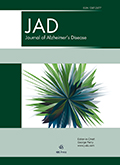Authors: Scharf, Annelie | Kleinke, Fabian | Michalowsky, Bernhard | Rädke, Anika | Pfitzner, Stefanie | Mühlichen, Franka | Buchholz, Maresa | van den Berg, Neeltje | Hoffmann, Wolfgang
Article Type:
Research Article
Abstract:
Background: The healthcare needs of People living with Dementia (PlwD) (such as Alzheimer’s disease) are often unmet. Information about the needs of community-dwelling PlwD and their association with sociodemographic and clinical characteristics is needed to fill the knowledge gap regarding factors influencing unmet needs among PlwD and to conduct a comprehensive needs assessment to develop tailored interventions. Objective: To describe sociodemographic and clinical characteristics of the InDePendent study population with particular reference to determinants of unmet needs. Methods: We analyzed baseline data of the multi-centre cluster-randomized controlled trial (InDePendent) using descriptive statistics to describe patients’ sociodemographic
…and clinical characteristics and Poisson regression models to predict unmet needs, separated by sex. Data were collected personally via face-to-face interviews. Results: Most of the n = 417 participating PlwD were mild to moderately cognitively impaired, were not depressed, had an average of 10.8 diagnoses, took 6.7 medications, and had, on average, 2.4 unmet needs (62% of PlwD had at least one unmet need) measured by the Camberwell Assessment of Need for the Elderly (CANE). Low social support, a high body-mass-index, a lower education, functional impairment, and worse health status were associated with more unmet needs, regardless of sex. In women, higher unmet needs were associated with more depressive symptoms, a poor financial situation, living alone and not being recently treated by a general practitioner. In males, unmet needs increased with the number of medications taken. Conclusions: PlwD had a broad array of unmet healthcare needs, indicating primary healthcare provision improvement potentials. The results underscore the significance of early assessment of patient’s clinical characteristics and unmet needs as a basis for individualized gender-sensible intervention strategies.∥ClinicalTrials.gov Identifier: NCT04741932, Registered on February 5, 2021
Show more
Keywords: KeywordsAlzheimer’s disease, Camberwell Assessment of Need for the Elderly (CANE), dementia, elderly population, health services research, needs assessment, people with dementia, primary care, randomized controlled trial
DOI: 10.3233/JAD-231173
Citation: Journal of Alzheimer's Disease,
vol. Pre-press, no. Pre-press, pp. 1-17, 2024





